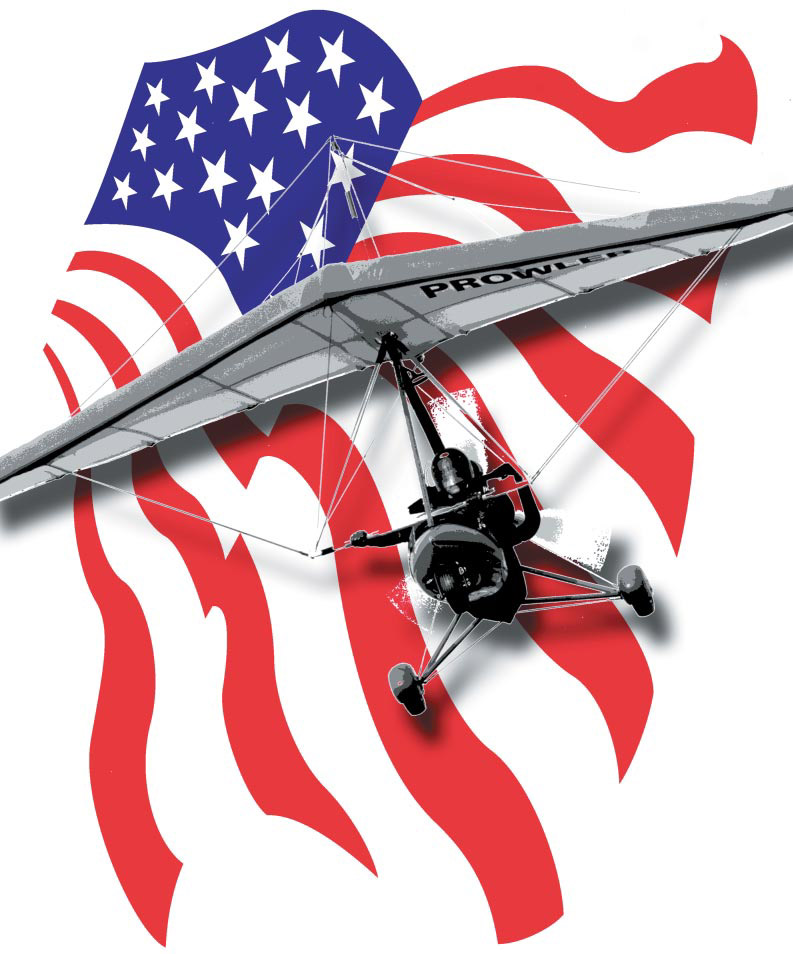
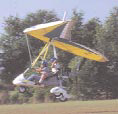
The Apache trike is North Wing’s two-place entry into the trike world. Fitted with a fairing and wheel pants, it competes with the more dressedout trikes produced by European manufacturers.
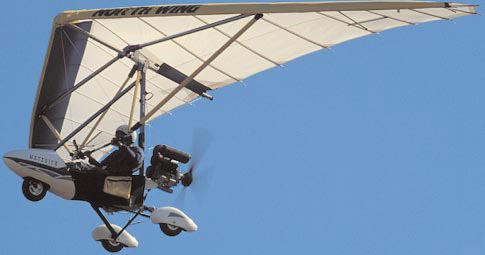
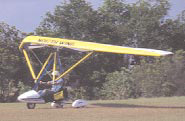
The Maverick, by North Wing Design, taxiing out and in-flight. It is the first trike introduced with a strutbraced wing as opposed to cables. North Wing Design is headquartered in Wenatchee, Wisconsin.

Kemmeries Aviation’s Trike Zilla trike features a very basic carriage. Kemmeries outfits their trikes with foreign wings, in this case the LeMouette wing manufactured by Chronos. Kemmeries also manufactures the Tukan model and imports a number of Air Creation trikes from France.

Sabre Aircraft’s Elite model, featuring a full-body fairing, is another of the dressier trikes “made-inthe- USA.” Sabre is arguable the country’s largest seller of trikes made in this country. Sabre Aircraft also imports the Venture 500 trike from the Ukraine, and partners with Arnet-Pererya in importing some fixed-wing aircraft.

Matt Taber of Lookout Mountain Flight Park gets airborne in his company’s SkyCycle. Lookout Mountain Flight Park is one of the country’s leading hang gliding schools and glider dealerships. Their development of a trike that can be used on a wing that a hang glider pilot already owns makes good sense. The SkyCycle appears to perform well.

Mike Jacober of Anchorage-based Arctic Sparrow Aircraft, taxies in with an Antares trike carriage mated with a North Wing Design wing. Jacober offers a variety of wings with the Antares trike, depending upon the purchasers experience and intended use of the aircraft. Sourced with American-sized tubing and bolts rather than metric, repair and replacement of parts on the North Wing wings is easier. In addition, many American pilots like the way the North Wing wings fly.

The WeTTrike, on land and sea. Introduced at Sun ‘n Fun 2001, the amphibious vehicle turned lots of heads. Ronnie Smith, of South Mississippi Light Aircraft, a veteran ultralight pilot and Rotax engine Repair Station, led the introduction of this combination trike/flying boat.
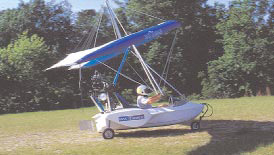

The Polaris Flying Boat originated in Italy, where it cut its teeth in resort areas along the Mediterranean Coast. The company has now established a base of operations in Florida. The Polaris Company began life as a hang glider manufacturer, but eventually moved onto powered trikes and lastly flying boats.

J&J’s SeaWing trike, with a North Wing Designs wing and mounted on Full Lotus inflatable floats, gets airborne off Lake Parker in Lakeland, Florida during Sun ‘n Fun 2000|and eventually lands back on the ultralight runway at Paradise City.
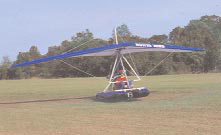

Don Cooney’s Prowler trike is probably one of the highest performing single-place units produced in this country. Cooney’s company is Concept Aviation, located in Tennessee. He is also a long-time ultralight pilot, with experience in both fixed-wing and weight-shift vehicles.

With a well-built carriage looking ready to transition to a trike wing, Buckeye Powered Parachutes has been experimenting with a variety of trike wings, initially offering a unit that could exchange its parafoil wing for a trike wing.

The Doodlebug represents what Dan Johnson calls “nanotrikes”-essentially harnesses attached to a power unit. Typically these aircraft appeal to hang glider pilots|but they look like for fun for all!
Made in the USA and Yankee friendly!
Many pilots and even some experts believe trikes are a European innovation. Indeed, producers across the Atlantic took the breed to new heights, yet the fact remains that the earliest commercial producers of weight-shift trikes were here in the United States. In the early 1980s trikes were primarily an American phenomenon.
In the early days, before ultralights
had been defined, hang gliders
added power and slowly evolved to
use wheeled carriages. The first
producers included brands that
transitioned from the hang gliding
world, such as Soarmaster, Bennett
Delta Wings, and Flight Designs (no
relation to the German producer of
the CT). All of these American names,
and a good many more, are now
gone.
Today, when you hear the word
trikes, you may think of Air Creation,
Cosmos, Pegasus, AirBorne, or other
companies from Great Britain,
Europe, or Australia. Most of the
development work in trikes has
seemed to come from imported
brands. Some pilots aren’t even aware
American companies build trikes.
In
fact, flying a weight-shift trike is often
viewed as a European thing to do;
true-blue Americans fly three-axis
designs|or so the common
perception goes.
In fact, that perception is wrong.
American companies have sprung up
to replace those long-departed
pioneers of the post-hang-gliding
days. These companies have
prospered and account for a sizable
chunk of all trikes sold in the United
States.
Like Harley, Like Trikes
America once led the world of
motorcycle production. Sure, lots of
other countries made motorcycles,
but much of the sport’s early
reputation was based on the likes of
Harley-Davidson, among other
brands.
Then came Japan Inc. Over many
years, Japanese-built bikes got better
and better. Honda, Yamaha, and
Suzuki seemed to dominate the
motorbike landscape. Eventually, a
financially troubled Harley-Davidson
nearly sputtered out of existence.
However, the Wisconsin-based brand
has now regained its prior shine and
market mystique.
Like Harley, American trikes led the
way in the early days of this aviation
genre. But when the Europeans
embraced the type, their
manufacturers invested in and created
better and better aircraft. They reset
the standard. In America, pilots and
manufacturers appeared to
concentrate on three-axis aircraft, and
trikes struggled along with a small
piece of the market pie.
But, like Harley, Yankee trikes are
back. As trikes have become a solid
part of the ultralight aviation
spectrum, U.S.-based builders have
reclaimed their share of the market. In
fact, they’ve done better than that;
they’ve also filled some areas of
development left vacant by the
manufacturers in other nations. The
reasons why are numerous.
An Inexpensive
Alternative
Europeans pay significantly more
for their aircraft than we do here in
the United States. High levels of
taxation are one reason (a 15 percent
sales-type tax is common), but dollar
for euro dollar, prices across the
Atlantic are higher due to
certification, registration, and
insurance. European pilots have also
demanded more feature-laden,
higher-performance machines. Trikes
in Europe sell for more than $30,000 when equipped with four-stroke
engines and elaborate carriages full of
equipment. Such prices don’t work
well here.
My visits to Europe during the
early days of ultralights identified the
source of the differences. While
America had a huge supply of used
general aviation airplanes that one
could buy for modest amounts of
money, Europe had little to compare.
Aircraft were scarcer. Airfields to use
them-at least for sport use-were
rare or dominated by sailplane gliders.
And fuel in orders of magnitude
more expensive.
In Italy, where auto gas exceeds $6
a gallon, a lowly Cessna 150 rented
for more than $100 per hour|and
this was years ago. In America, the
same aircraft was available for $20 to
$30 per hour. No wonder Europeans
embraced ultralights/trikes as another,
more economical way to fly.
So ultralights crossed the Atlantic
in flocks. Quicksilvers once sold
briskly on the other side of the
Atlantic. In 1982, I represented Flight
Design and tried to sell Europeans on
the trike concept (the U.S. company
was starting to sell the Jet Wing trike).
When ultralights of any kind were
new in Europe, few trikes existed.
Still today, Americans enjoy a huge
variety of aircraft that we can buy.
Ultralights, including trikes, compete
for sales against 25-year-old Cessnas.
Kit-built aircraft of many descriptions
and ultralight manufacturers compete
with each other-with an amazing
diversity in the ultralight arena alone.
All of this competition tends to hold
prices down.
Newer Entries
Foreign producers deserve credit for
their persistence at marketing trikes to
three-axis-oriented Americans.
Standout companies like AirBorne
and Air Creation have consistently
spent many dollars traveling long
distances to promote their slick trikes
to Yankee aviators. American
companies were not invisible, but the
large air show spaces occupied by
these international producers with
their highly evolved trikes brought
more attention to the segment.
Because of their efforts, an
increasing number of pilots began to
pay attention to trikes, and today,
estimates show the weight-shift
machines account for somewhere
between 1/6 and 1/4 of ultralights
flying in the United States. Naturally,
steady buyers of trikes brought more
producers to the party. But, European
trikes are deluxe and priced to match,
so it should not be surprising to hear
that American trike builders have
largely focused on simpler airframes
that sell at modest prices.
Companies popping up in the last
decade include Sabre Trikes,
Kemmeries Aviation, North Wing
Design, Concept Aviation, Butterfly
Wings, TC’s Trikes, Top Dog
Ultralights, Skyboat, and WeTTrike
Inc.
Other producers have come on the
scene from a different direction.
Powered parachute producers like
Buckeye believed their carriages were
adaptable to trike wings in addition to
parafoil wings. Most observers
acknowledge that powered parachute
producers build some handsome
carriages, so the combination makes
sense.
Others also joined this parade with
Canadian producer Para-Ski showing
video of a powered parachute carriage
under a delta wing that had just
replaced a square parachute wing. To
date, none of these convertible
systems have found a big market, but
they did help diversify the companies
building them.
Companies like Sabre, Kemmeries,
and North Wing Design are “Made in
the USA” builders that have been able
to compete alongside the sleek entries
from other nations. Though Sabre has
begun importing a trike from the
Ukraine (Venture 500), it still does a
good business with its Arizonaproduced
models. By many accounts,
Sabre remains one of the largest
suppliers of trikes among Yankee
builders.
Kemmeries Aviation, long a player
at importing trikes, also has its own
production models, the Trike Zilla
and Tukan. In particular, the Tukan
model has found favor, even boasting
a second producer-Roger Johnston’s
J&J Ultralights, a veteran enterprise
that also makes the Model C trike and
the SeaWing. Proprietor John
Kemmeries has represented Air
Creation in this country for many
years. As the American market
become more valuable to the French
manufacturer, Kemmeries saw an
opportunity and recently bought a
substantial percentage of Air Creation.
North Wing Design was born of a
hang gliding company. Company
founder Kamron Blevins built
replacement parts for abandoned
hang glider designs. From this
enterprise he branched into making
trike wings for producers who only
built the trike carriage. North Wing
Design still does that, but more
recently it has offered buyers a line of
whole trikes, including the singleplace
Maverick-the first trike with a
wing that has struts instead of upper
cable rigging-and the soaring trike,
ATF (Air-Time Fix). Just a couple years
ago, North Wing Design added its first
two-place trike, the Apache.
Concept Aviation, with Don
Cooney handling the one-man shop,
has made a distinctively different trike
in the single-place Prowler. It is one of
the first American models to feature
higher speeds and snappy handling
from a more highly loaded wing.
All the above builders have their
focus and are players in the growing
market for trikes in the United States.
However, trikes are like three-axis
designs in that they can go many
directions. “Made in the USA”
builders appear to have gone places
with trikes that the European
designers chose not to go.
Flying Boats
I was part of early attempts to work
with trikes on floats. With no way to
steer in the water and no protection
for the prop, we struggled to perform
a water taxi (you had to alternately
dip one wing and then the other in
the water to zigzag your way to
shore). Spray from improperly placed
and too-small floats caused us to chew
through numerous wood props
(composite props weren’t available for
ultralights in those days).
Today trikes are fitted with floats
more routinely, and they work well
enough. But the concentration of
effort seems focused on the boat-style
hull in lieu of separate floats. One
positive: it protects the prop. Several
different brands compete for
customers.
The granddaddy of this concept is
a European company called Polaris.
They initially produced hang gliders
but later moved into powered trikes.
Eventually, flying boats took over the
entire company, though they retained
their knowledge and expertise in
building wings for trikes. Polaris
experimented with an inflatable boat
as the hull or floats for one of their
trikes back in the late 1980s. Being
even more unusual looking than
trikes alone, the concept worked in
the world of beach resorts where
tourists look for new things to do.
Entrepreneurs today operate
hundreds of these at beach resorts
around the world, and a reported 1,200 of them are the Flying Inflatable
Boat, or FIB, from Polaris.
But as we enter 2002, several
American producers are taking a
piece of the action. J&J Ultralights’
SeaWing is one of the more
established. The SeaWing is quite
unique in that it has a wing you can
fold, with a hand crank, while it
remains on the trike. J&J has worked
with wing provider North Wing
Design to accomplish this.
More recently, Personal Flight-the
importer of Cosmos trikes-has
offered its own Sky-Tender made of
parts originating in Italy, France, and
Austria but assembled and finished in
the United States. Thus, Sky-Tender
isn’t truly made in the United States,
but the idea was an American one
and Personal Flight owns the name.
Still newer entries include the
radically different flying boat (with a
non-inflatable hull) called WeTTrike
from a company of the same name,
organized by ultralight veteran
Ronnie Smith of South Mississippi
Ultralights. Another is the Soaring
Eagle Incredible Flying Boat. (I was
unable to contact Soaring Eagle before
press time, despite numerous
attempts.) In time, U.S. companies
may come to dominate this niche of
the market. Meanwhile, in another
sign of increasing American interest
in the trike concept, Polaris founder
Doi Malingri has set up the Polar Star
Group in Florida.
Nanolight Trikes
Another piece of the American
trike puzzle is super-light trikes.
European hang glider enthusiasts
have developed some “powered
harness” systems that are not trikes in
the usual sense. Sweden’s Mosquito,
Britain’s Pegasus Booster, and the
Flylight Doodlebug are examples of
power units attached to a harness
that supports a hang glider pilot.
Usually these are foot launched,
though some wheel-equipped models
like Germany’s Minimum are in use.
They overwhelmingly sell to hang
glider pilots.
Americans took a different
direction, and the niche is still
developing. In the United States, trike
carriages like Lookout Mountain’s
SkyCycle and North Wing Design’s
ATF have offered hang glider pilots
the minimum in wheeled carriages
with weights below 100 pounds for
the chassis components, including
engine and prop. Others are in
development at this time. Both
American nanotrikers made their
machines significantly lighter than
the French Cosmos Samba, but they
are on par with the Italian Polaris Slip.
Yet another variation on the theme
involves the powered paraglider entry
to trikes, which are usually foot
launched. Over the years of their
evolution, tiny trike carriages have
emerged for those who don’t want to
run. And it had to happen that these
builders discovered a conventional
hang glider wing could work as well
as the paraglider wing with a few
extra pieces of hardware. Powered
paraglider trike producers found a
market in those who like the
convertibility of using two kinds of
wings. Since both are lighter than
regular trikes or powered parachutes,
the wing-swap method seems to
function better.
Two leading producers of these
convertible trikes are Airsports USA
with their DFS trike and Japan’s
Whisper. Formerly located in Greece,
Airsports USA is a now an American
company, and the New York-based
operation says it now produces all
parts domestically.
Domestic Content,
Foreign Opportunities
Exactly what does “Made in the
USA” mean? How did I determine
which American trikes to include in
this article?
Automobiles “Made in the USA”
aren’t|not completely anyway.
Virtually every finished product built
in America has some components
that are imported. Complicating
matters, imports are sometimes from
a partly or wholly American-owned
company operating overseas, a
process sometimes called reimporting.
Therefore, my criterion was 51
percent, much like the amateur-built
rule. If more than half the aircraft
comes from American-sourced
material AND if the aircraft is
assembled for kit or ready-to-fly
delivery in the 50 states, then I
considered it “Made in the USA.”
A great majority of U.S.-built
ultralights use the Rotax engine, an
Austrian-imported brand. If an engine
runs 25 percent or more of the unit’s
total cost, those aircraft are basically
somewhat imported. However, a
majority U.S.-built airframe still
makes it a “Made in the USA”
product.
In another kind of re-import,
Alaska-based Arctic Sparrow Aircraft
has adopted the Antares trike from
the Ukraine. After selling fully
imported models of this trike, Arctic
Sparrow proprietor Mike Jacober
changed gears. When the
experimental amateur-built glidertrike
category became a reality and
with the proposed sport pilot rule on
the horizon, Jacober wanted to make
a fully amateur-built aircraft out of
the trike. This process has never been
validated as thoroughly as Jacober has
done with the Antares’ designer,
Ukrainian partner Sergey Zozulya.
Mike found Zozulya’s Antares
design to be tough enough for
American use as a hunting and
fishing vehicle and for flights into the
wilderness, which Alaska has a lot of.
Being involved with the glider-trike
rule, Mike further wanted an aircraft
that FAA would approve for this
application. It needed to be a kit, but
trikes are usually not kits. European
and Australian regulations have
allowed manufacturers to sell readyto-
fly machines, so companies in
those countries prefer to deliver
aircraft that require only quick-field
assembly from shipping containers.
For the past 15 months, Sergey
and Mike have worked ceaselessly
to create an American-sourced
aircraft fitted to the 51-percent rule.
They’ve even created a fully
documented assembly manual with
more than 400 photos and step-bystep
written instructions, edited
carefully by an American expert.
“Ninety-five percent of the bolts,
all the tubing, and many other parts
are bought here in the USA,” says
Jacober. “Many of the manufacturing
jigs have been transported to Alaska
from the Ukraine,” he adds. But the
sail and certain labor-intensive parts
are still sourced from the Ukraine.
“You can’t beat their labor cost.”
Nonetheless, the kit alone passes the
“domestic content” rule. When an
Antares Ltd. trike flies in the United
States, it will be mostly Americanmade.
The American Way
As usual, we did it our way.
American trike builders have
addressed the American market in
ways foreigners never could. You
have to live in a culture to fully
appreciate it. The international
supplier may offer a selection of
certificated trikes (some will surely
qualify as light-sport aircraft), but
American trike builders understand
American trikers the best.
I take nothing away from several
superb trikes from far-off lands, but
the good ol’ “Made in the USA” label
still has lots of influence. Americans
will buy plenty of imported trikes, but
many love the way homegrown
builders meet their requests. Perhaps
this shouldn’t be a surprise, given that
Yankees invented the original trike.


Are older trikes still safe to fly?
Daniel: Certainly an older trike can remain airworthy but before you buy something for a bargain, spend a few dollars hiring a qualified mechanic to review it.
I’m new and still teaching myself to fly. I got the crashing part down with just a broken wing. I got it fixed and I’m back taking it easy before I turn my Quicksilver into a lawn dart. I just need to build my confidence level up to stay up.